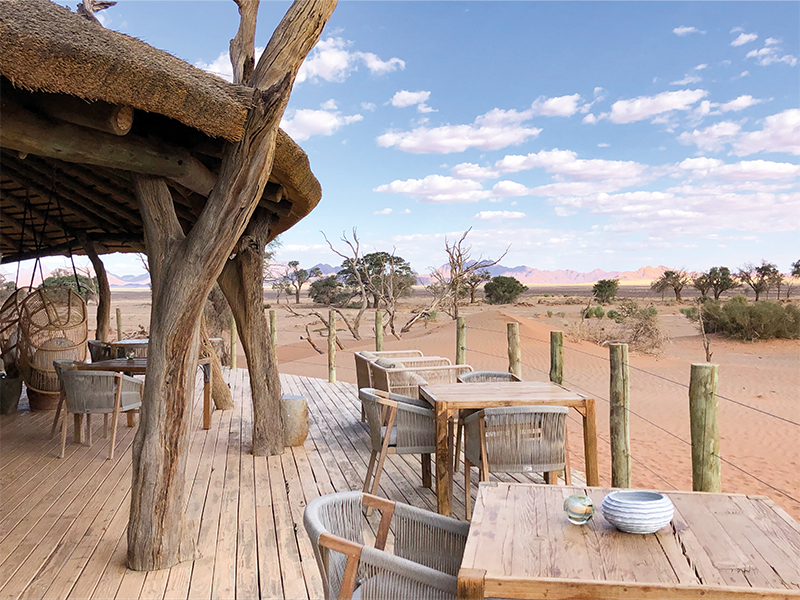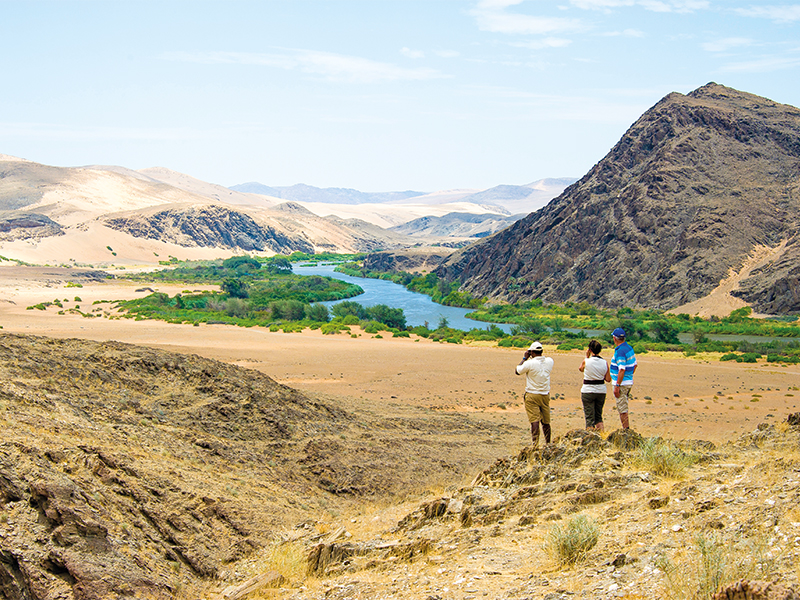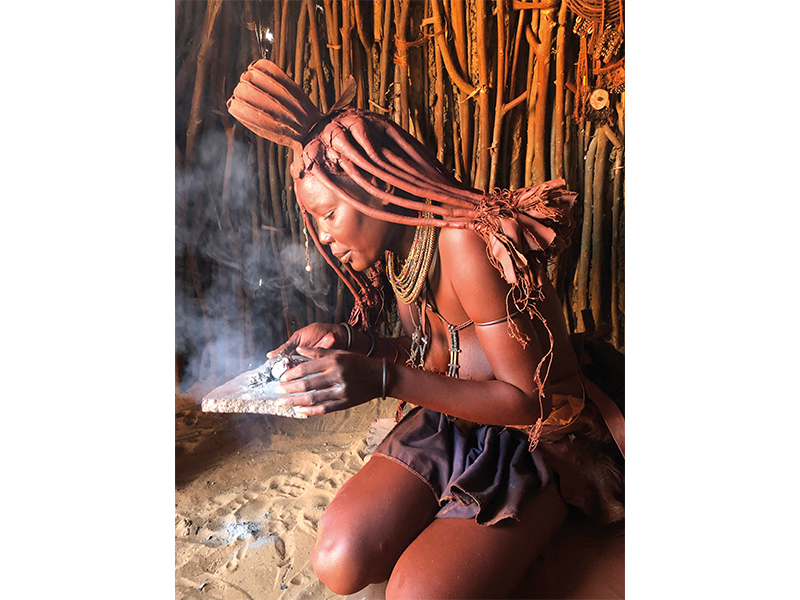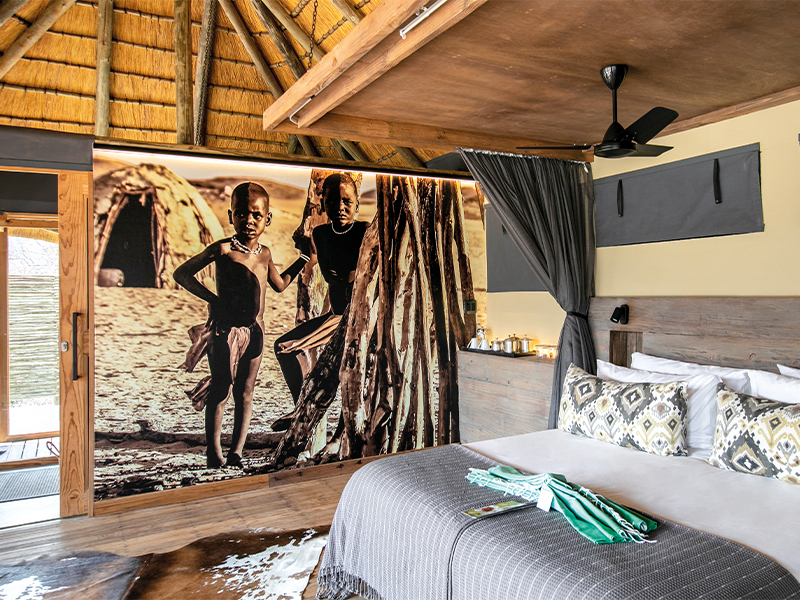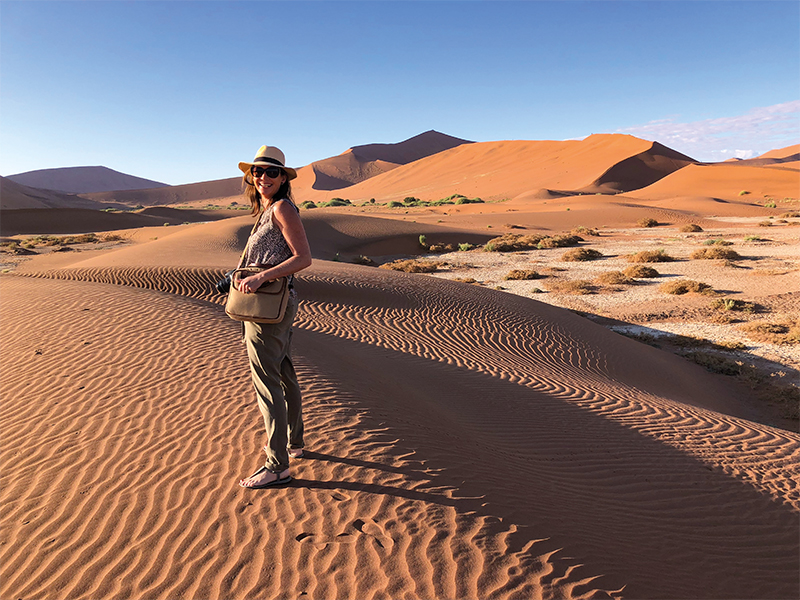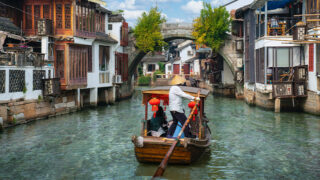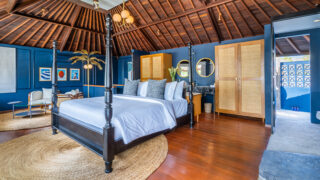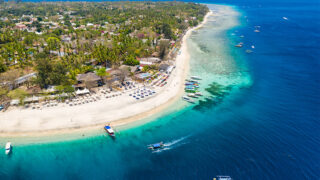The marvel of our planet’s endurance can clearly be seen in Africa’s Namib desert, the oldest desert on earth. I loved what I saw of this incredible part of Namibia on this trip; and I’m just waiting for the next opportunity to discover more of it!
Part 1: Sossusvlei
Namibia in Africa encompasses an area one and a half times the size of France, yet with a mere two million people. In the intimate camps of luxury safari operator Wilderness Safaris, you’ll hardly see a soul, making them a fitting place to connect with yourself or your loved ones; a place to restore or reflect.
Amazing landscapes
From Windhoek International Airport in the Namibian capital, we flew in a small plane – with a pilot named Maverick, no less! – to an area in the southern part of the Namib Desert called Sossusvlei. Light aircraft flights are an underpinning element of luxury travel; they allow you to cover expansive distances to reach remote and unique settings. In this instance, each flight we took was astonishingly scenic. It’s unfathomable that one country could showcase such a variety of landscapes. On the way to Sossusvlei, the sky and sand offered ever-changing and impressive scenes for the duration of the journey. Eventually, we dipped down towards the undulating red sands.
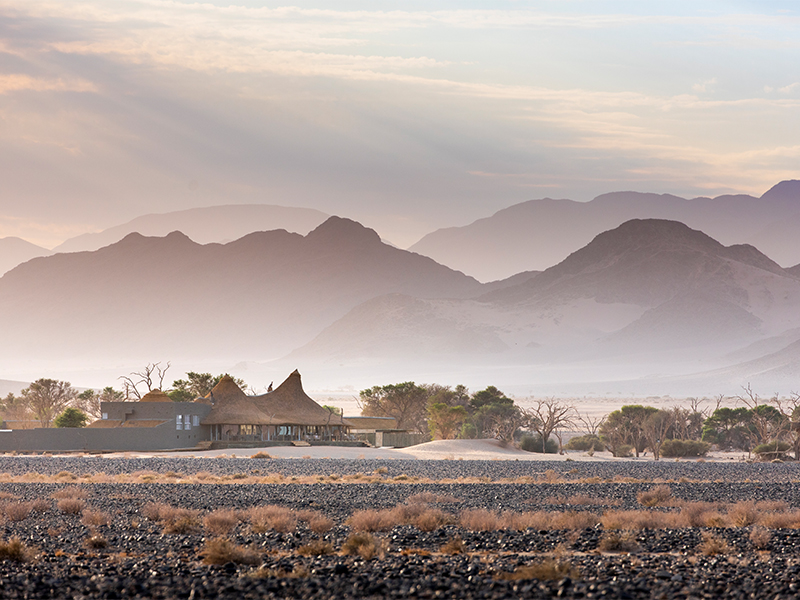
From the ideally situated luxury camp of Little Kulala, you take a trip through the corridor into the Namib- Naukluft National Park, where towering dunes cover an area of 20,000 square kilometres. This is a place where you can’t help being intrigued by the geological conversation. To sum up; the desert is a result of transportation of sand by wind from the Kalahari. The high quartz and iron content give it a rich red colour.
A “vlei” refers to a place where water collects. We had the fortune of seeing Sossusvlei with water – a sight limited to just once or twice a decade! However, the nearby and famous Dead Vlei has been dry for over 900 years. Without moisture and bacteria to decay the trees, they continue to bake in the sun timelessly. Here they stand in the white sediment, brought by rivers centuries ago, and set against the ochre desert.
A lady in red
From our lofty ascent up “Big Daddy” dune, we looked down onto a woman in red, moving through the stark vlei below. What a flamboyant picture she cut! Stopping to chat, I was reminded how visiting a place like this is an equal privilege for Namibia’s own people.
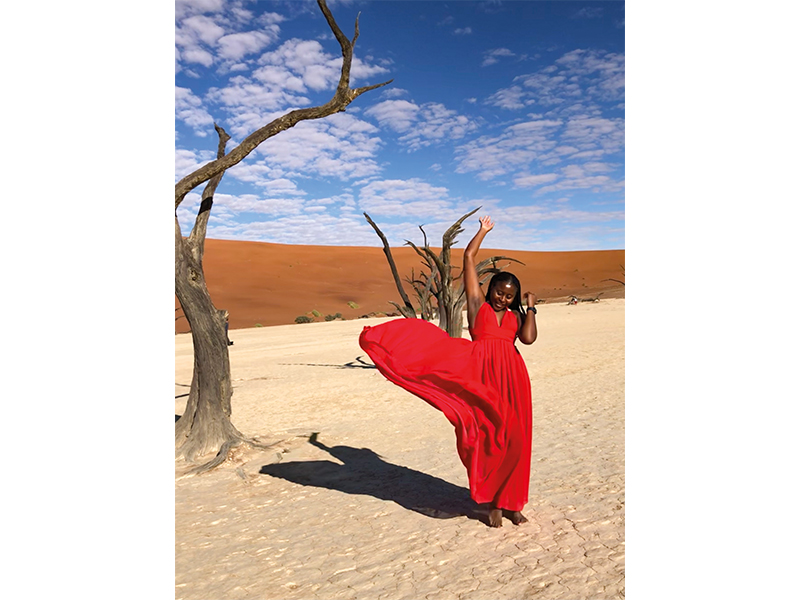
In preparation for her adventure she’d even researched what colour would show up best for her photos. Then, she’d sewn her own red ballgown with a vision for taking striking selfies! Next, she drove overnight from a faraway town to experience this wonder of the world. The image of her billowing scarlet chiffon contrasting with the extraordinary backdrop and cobalt sky will stay with me forever.
Desert lodgings
Little Kulala lodge offers a haven in this arid setting. The soft furnishings of mauve and pink carry through the colours seen in the surroundings outside. Each guest suite has a private rooftop deck to enjoy sunrise or sundowners.
Sunset in Namibia is remarkable every evening. As the golden sun dips below the horizon, the sky becomes a kaleidoscope of colour. Horizontal stripes of liquid orange fade to indigo. The predominant pink hue comes from the fine dust particles of the desert. The cloudless sky, far from anywhere, promises intense starry nights so remarkable that the camp staff make up the option of a second bed – outdoors, on your private deck.
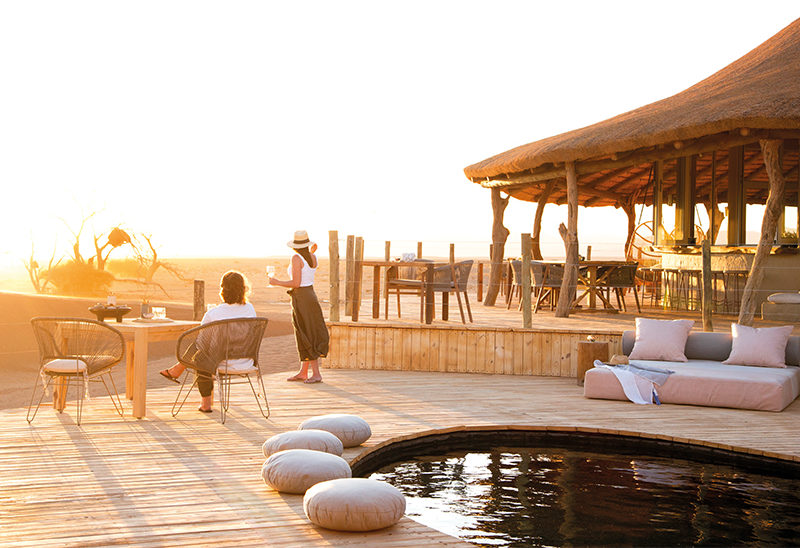
During the day, the lodge’s quad bikes made for an exhilarating way to traverse the expansive terrain. We enjoyed the panoramic scenery, while seeing indigenous birds, oryxes, zebras, ostriches and jackals. It’s evident that nature is working patiently all the time here. The simplest sight of grass seeds carried in a light breeze prompted our guide to show us how these then burrow like little screws into the earth. They’ll lie dormant for years, if need be, until rains eventually fall allowing them to germinate and bring new growth.
Part 2: Serra Cafema
Flying North to our next lodge took us over Namibia’s highest mountain, Brandberg (2,573 metres). I felt like I could reach down and touch it. The earth below looked robust, mature, grounded and unbeatable. Onward we went, and over evidence of the Gondwana split. The ice age seemed incomprehensible in such heat, but you could see where glaciers had moved in the past.
Ancient rocks
Arriving at the remote dirt airstrip in the isolated Hartmann Valley, I was overcome by an overwhelming sense of solitude. Transferring to a vehicle, we crossed through areas that were previously molten lava, and over more open desert plains. Our guide pointed out where the metamorphosis of minerals in linear deposits repeatedly etched the landscape. Great shards of sharp rocks protruded, and crystal-like broken chunks of quartz abounded.
The sanctuary that is Serra Cafema lodge sits stilted on the verdant banks of the Kunene River, which appeared like a bright green ribbon in a rocky moonscape as it came into sight. Birds abound and restful loungers beckon beside the plunge pool, inviting gin and tonics overlooking the river that forms the border with Angola. Across the banks, a sheer cliff looms. It showcases veins of quartz in the rocks, with noticeable zigzag patterns etched by movement of tectonic plates eons ago.
A visit to the local Himba people gives insights into the ways of this semi-nomadic tribe. The team from Wilderness Safaris follows a strict code of conduct on the engagement with rural communities. It offers meaningful, authentic interaction without imposing on these indigenous people.
Part 3: Hoanib
Hoanib offers a stylish, contemporary lodge with pale olive-tented covers on top of individual luxury suites. Desert-adapted elephants, lions and rare brown hyenas are the prized sightings in this harshest of landscapes. These predators can traverse great distances. The greatest threat to them is through their interactions with neighbouring communities as they are tempted by the easy pickings of livestock. Huge efforts are made to collar, track and protect the few lions so as to avoid human interaction. For me, seeing a lioness and elephant in the desert was inconceivable. A rare phenomenon.
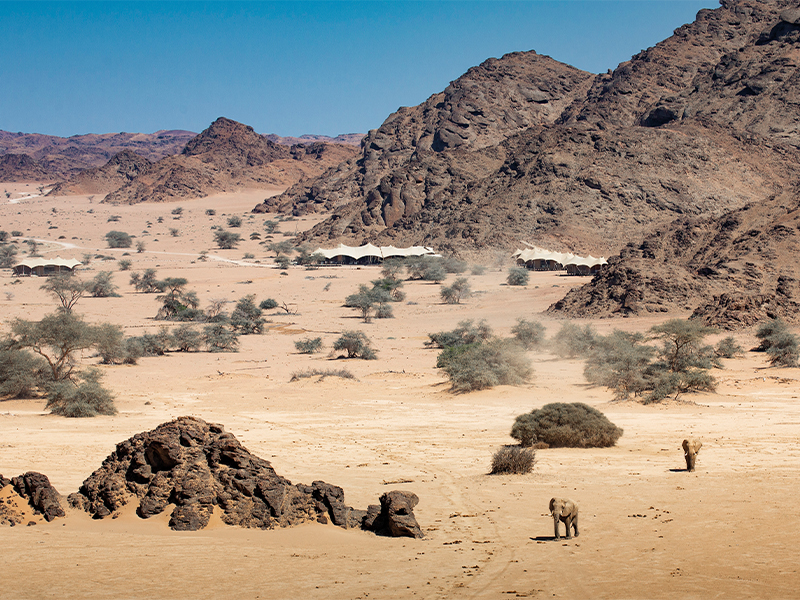
It takes a day trip to the shore (consisting of an informative day-long drive through the sand and then an eight-minute flight back) to understand the link between this desert environment and its proximity to the sea. The meandering, dry, sandy river bed along the way is indicative of where water occasionally travels to the sea in torrents from the interior. What’s more, the sheer drop of the river bank is at times as high as a three- or four-storey building, a result of flooding water carving its way to the ocean, before vanishing into the sand once more.
The Skeleton Coast
The puzzle fits together when you see where the Hoanib River reaches the coast – aptly named the Skeleton Coast. While the desert is searingly hot, the hostile coastline is bleak, as an icy cold fog rolls in off the frigid Atlantic waters. A colony of thousands of seals made me feel like I was in a David Attenborough documentary. Sharks, vultures and hyenas all prey on the abundant seals. Two of the resident lionesses of the area have even become adept seal hunters, crossing the vast desert to reach them on the rocky shore.
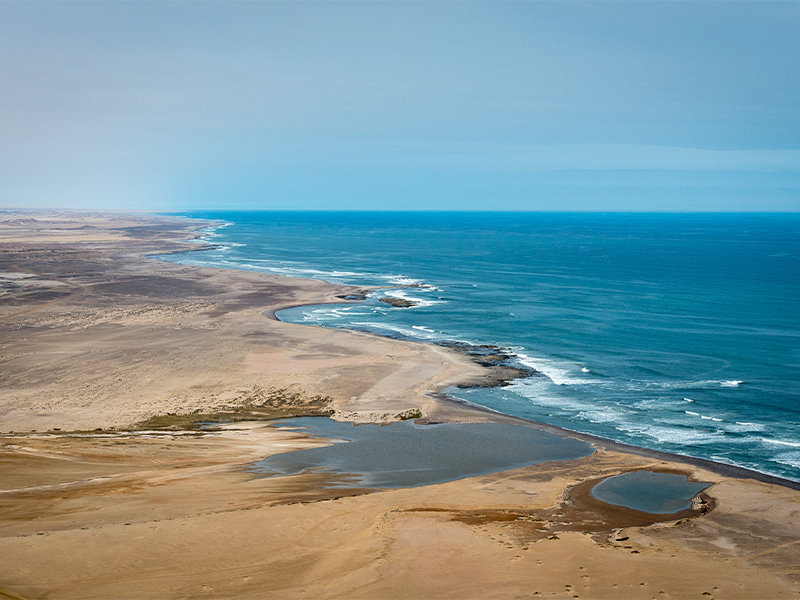
Pebbles churning in the breaking waves are the result of polished gemstones originating from the rough rocks seen in the dry river bed near the camp. Their clinking sound was far more peaceful than the barks, honks and grunts of the seals. With its whale bones and shrieking seagulls, this place is bleak and barely inhabitable. Even the metal of a 40-year old shipwreck reverts to its rusty mineral state in the salty air. It’s not called the Skeleton Coast without good reason.
But you’ll return to the quiet comfort of the lodge, knowing more, as you restfully relish the comfort of Wilderness Safaris’ luxurious suites in a unique place that’s more than just out of the ordinary.
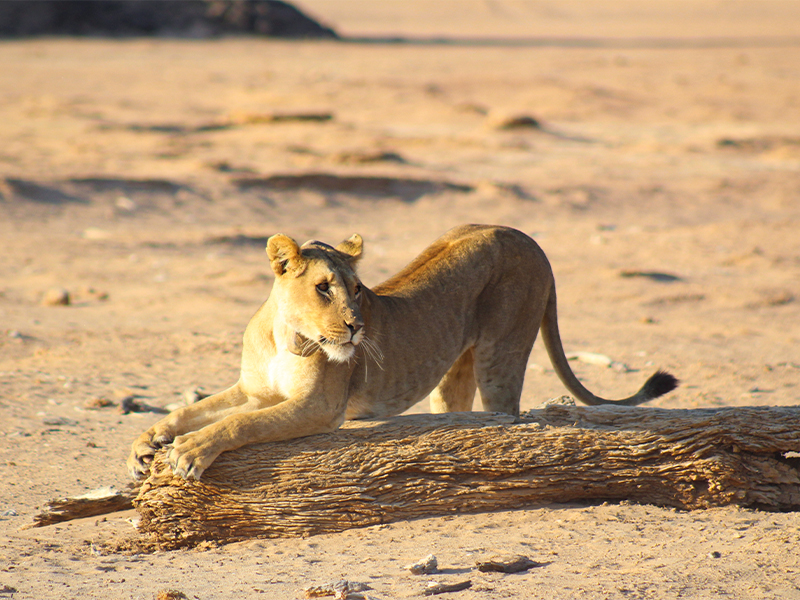
Fact File
Getting to Namibia
A flight to Windhoek is a little over two hours from both Cape Town and Johannesburg. Namibia is a peaceful and unhurried destination, ideal for a standalone adventure. You could also consider combining this geology-focused trip with a traditional safari in neighbouring Botswana, Zambia, Zimbabwe or South Africa.
If you need a hotel in transit, the Am Weinberg Boutique Hotel in Windhoek offers a comfortable stay, with state-of-the-art facilities in a restored heritage building. Visit gondwana-collection.com/accommodation/the-weinberg.
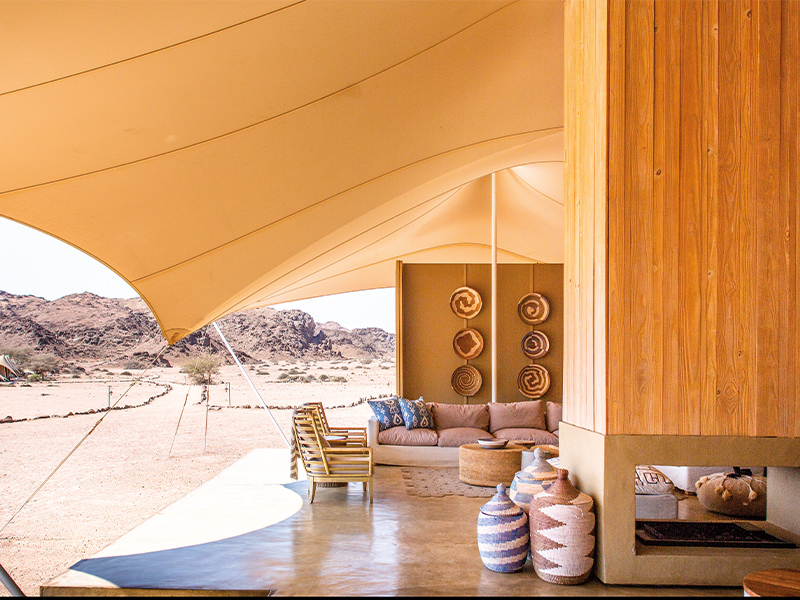
Wilderness Safaris and conservation
Acknowledging the subtleties of treading on sensitive terrain, in amongst nomadic cultures and vulnerable wildlife, Wilderness Safaris allocates a portion of every bed-night spent to conservation, while another goes to community upliftment programmes. While a journey with this group will change your life, it will also change that of those less fortunate than you. It will give your African journey purpose, and make a positive impact on educating young people to protect their magnificent natural heritage. Find out more at wildernesssafaris.com
This article first appeared in the July 2022 edition of Expat Living. You can purchase the latest issue or subscribe, so you never miss a copy!
Need a holiday? Head to our travel section for the latest scoops!

